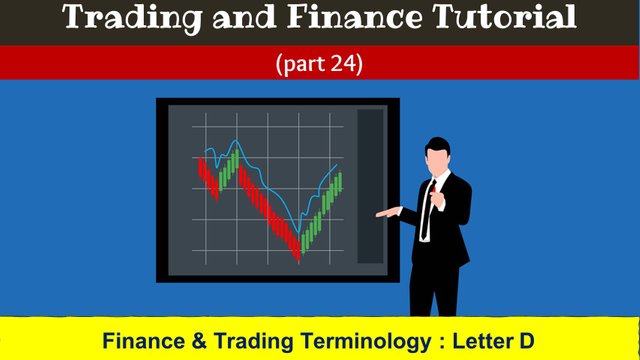Basics of Trading and Finance (Part 24) : Trading and Finance Terminology : D (71-95)
Intro
IntroAs a moderator of the Tron Fan Club community, I regularly write various tutorials on crypto blockchain and Tron related matters. The main purpose of these tutorials is to make our new users aware of these topics. In continuation of that I am writing tutorials on trading and finance. Hope you can easily learn some details of trading and finance through this tutorial series.
Trading can feel scary if you don't know much about it. That’s why I bring you simple tutorials to help you understand trading basics step by step. Trading involves buyers and sellers, prices, and exchanges. Today, let's learn some important trading terms starting with the letter "D."
71. DAO (Decentralized Autonomous Organization)
A DAO is a group run by rules written in code, not by people. Decisions are made by token holders through voting.
72. dApp (Decentralized Application)
A dApp is an app that runs on a blockchain, not a central server. For example, Uniswap is a dApp for crypto trading.
73. Day Trading
Day trading is buying and selling assets within the same day to make quick profits. Traders take advantage of small price changes.
74. Death Cross
A death cross happens when a short-term moving average crosses below a long-term moving average, signaling a downtrend.
75. Decentralization
Decentralization means no single authority controls the system. Bitcoin is decentralized because no bank controls it.
76. Decryption
Decryption is the process of converting encrypted data back into its original form to read it.
77. DeFi (Decentralized Finance)
DeFi refers to financial services like lending and borrowing that work on blockchain without banks.
78. Deflation
Deflation is when prices go down over time, increasing the value of money. Bitcoin has deflationary properties because of its limited supply.
79. Delegated Proof of Stake (DPoS)
DPoS is a blockchain consensus system where users vote for delegates to confirm transactions.
80. Demand
Demand is how much people want to buy an asset. High demand usually raises prices.
81. Depreciation
Depreciation is when an asset loses value over time. For example, phones lose value as new models come out.
82. Derivative
A derivative is a financial contract whose value depends on an underlying asset, like Bitcoin futures.
83. Digital Asset
A digital asset is anything valuable stored digitally, such as cryptocurrencies or NFTs.
84. Digital Currency
A digital currency exists only online and is used for payments, like Bitcoin and USDT.
85. Distributed Ledger
A distributed ledger is a shared record of transactions stored across many computers.
86. Divergence
Divergence happens when an asset’s price moves in the opposite direction of an indicator, signaling trend changes.
87. Diversification
Diversification means spreading investments across different assets to reduce risk.
88. Dividend
A dividend is a portion of a company’s profit paid to its shareholders.
89. Dogecoin
Dogecoin is a popular meme cryptocurrency that started as a joke but gained a large following.
90. Dolphin
In crypto, a dolphin is someone with a medium amount of holdings, not too small like a fish, not too big like a whale.
91. Domain
A domain is the web address of a website, like steemit.com.
92. Double Spend
Double spending means using the same crypto twice, but blockchain prevents this by verifying transactions.
93. Dumping
Dumping is the act of selling large amounts of an asset below market price to drive competitors out.
94. Dust
Dust refers to very tiny amounts of cryptocurrency left in wallets after trades, often not worth transferring.
95. DYOR (Do Your Own Research)
DYOR is a common phrase in crypto, meaning always research before investing instead of relying on others' advice.
These were some important terms in trading and crypto starting with "D." Learning them will help you trade more confidently. Thanks.
Click to Join our Discord Server



Upvoted! Thank you for supporting witness @jswit.